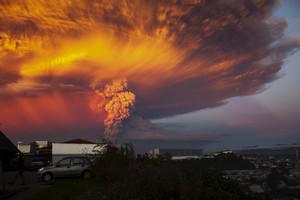Volcanic eruptions Scientific challenge: Better preparation for volcanic eruptions
Volcano monitoring is critical for forecasting eruptions and mitigating risks of their hazards. However, few volcanoes are adequately observed, and many are not monitored at all. For example, fewer than half of the 169 potentially active volcanoes in the U.S. have any seismometers – an instrument to detect small earthquakes that signal underground magma movement. And only three have continuous gas measurements, which are crucial because the composition and quantity of dissolved gases in magma drive eruptions. Enhanced monitoring combined with advances in experimental and mathematical models of volcanic processes can improve the understanding and forecasting of eruptions, a new report says.

Unexpected Chilean vulcano eruption seen from a distance // Source: theconversation.com
Despite broad understanding of volcanoes, our ability to predict the timing, duration, type, size, and consequences of volcanic eruptions is limited, says a new report by the National Academies of Sciences, Engineering, and Medicine. To improve eruption forecasting and warnings to save lives, the report identifies research priorities for better monitoring of volcanic eruptions and three grand challenges facing the volcano science community.
Volcano monitoring is critical for forecasting eruptions and mitigating risks of their hazards. However, few volcanoes are adequately observed, and many are not monitored at all. For example, fewer than half of the 169 potentially active volcanoes in the U.S. have any seismometers – an instrument to detect small earthquakes that signal underground magma movement. And only three have continuous gas measurements, which are crucial because the composition and quantity of dissolved gases in magma drive eruptions. Enhanced monitoring combined with advances in experimental and mathematical models of volcanic processes can improve the understanding and forecasting of eruptions, the report says.
NAS says that the committee that conducted the study and wrote the report also highlighted the need for satellite measurements of ground deformation and gas emissions, drone observations, advanced seismic monitoring, and real-time high-speed acquisition of data during eruptions. New approaches in analytical capabilities to decipher magma history, and conceptual and experimental models of magmatic and volcanic phenomena, will provide new insights on the processes that explain how magma is generated and erupts.
“There have been great improvements in conceptual models of volcanic phenomena, compared with those used a few decades ago, but the volcano science community is not yet adequately prepared for the next large eruption,” said Michael Manga, professor in the department of earth and planetary science at the University of California, Berkeley, and chair of the committee. “There are fundamental challenges that need to be addressed and require a sustained effort from across disciplines. By working toward these grand challenges, the volcano science community can help quantify the global effect of eruptions and mitigate hazards, ultimately benefiting millions of people living in volcanically active areas.”
The committee outlined several key questions and research priorities in areas such as the processes that move and store magma beneath volcanoes; how eruptions begin, evolve, and end; how a volcano erupts; forecasting eruptions; the response of landscapes, oceans, and the atmosphere to volcanic eruptions; and the response of volcanoes to changes on Earth’s surface.
